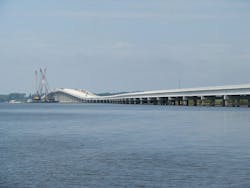No. 3 - Choctawhatchee Bay Bridge
As it stretches across a bay in the northwestern region of the Sunshine State, the completion of the Choctawhatchee Bay Bridge faced considerable obstacles due to restrictions caused by the sensitive marine environment inhabited by endangered species.
The team at Skanska USA had a limited timeframe to drive precast piles to the jobsite as a result of a “fish window,” a moratorium on pile driving during an extended period in the year that lasted several months. The team was unable to drive their piles until the moratorium was lifted.
“By then, it was go time,” project manager Gary Worley told Roads & Bridges. “We had five months to drive all the piles before the next fish window, which was six months long.”
Due to highly variable soil conditions, the design-build team utilized a very thorough test pile program to establish pile lengths. A test pile was installed at every pier and an average of four restrikes, at varying depths, were performed on every test pile.
To meet the demands of their schedule, Worley’s team had to push through four months worth of power-driving weeks, going seven days a week for 14 to 15 hours per day. Helping to alleviate the pressures of this schedule was the method of maintaining a high percentage (> 75%) of precast piles on the job. “The only thing we really had to cast in place on the jobsite was the actual deck itself,” Worley said.
Consistent monitoring and control of vibrations during construction was necessary as the project was in close proximity to another bridge. “A lot of our equipment was right beside traffic,” Worley said. “We had to make sure that our crane booms and [other equipment] were extremely well-engineered to make sure we didn’t have any crane collapses onto traffic.”
A plus for the region during the construction portion of the project was that the traffic impacts were minimal. “The only impact to traffic was at night [when] we poured our cast-in-place decks,” Worley explained. The team would shut down one lane per night to pour decks between the hours of 9 p.m. and 4 a.m., implementing an efficient strategy to keep from inhibiting traffic flow.
Work on the Choctawhatchee Bay Bridge is part of a series of projects the Florida Department of Transportation is working on to expand U.S. 331 from two lanes of traffic to four, in order to double the volume for 60 miles of traffic between U.S. 98 and I-10.
Location: Walton County, Fla.
Owner: Florida Department of Transportation
Designer: WSP Parsons Brinkerhoff
Contractor: Skanska USA
Cost: $118.5 million
Length: 2.5 miles
Completion Date: May 14, 2016
